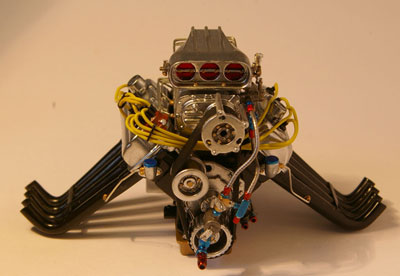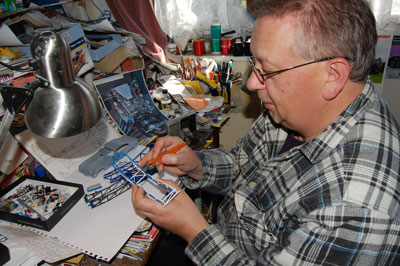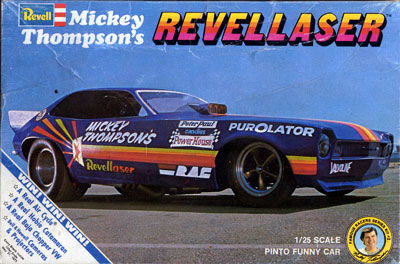

Model citizen
Most of us hard-core drag racing fans built plastic models in our youth – and a lot of you apparently still do – but I have to admit that I was never very good at it. Sure, the pieces would all end up in the right places and the decals mostly straight, but other than gluing three or four blowers atop one another or chopping the roof off of a car, I was never much into experimentation or customization, let alone the intricate hand-fabrication that some of the avid model builders take on as if they were whipping up microwave popcorn.
There are guys like me, whose greatest attention to detail was making sure that most of the excess glue got wiped away, and there are guys who made their own fuel lines or custom paint jobs or adapted generic models into accurate reproductions of nonavailable cars, and then there are guys like Mark "Gredzo" Gredzinski.
You've seen his name and work in this column as a talented British artist with an infatuation with 1970s Funny Cars (join the crowd), but his newest projects are beyond belief.

|

|

Mark Gredzinski's homemade barrel valve, left, which comprises 30 pieces, and his scratch-built fuel pump
|

The artist at work on his Buttera chassis, made from his own blueprints (below)
|
 |
 |
He's creating what he hopes will be "the world's most accurate circa 1972 model nitro engine," a 16th-scale powerplant that he plans to place between the framerails of an equally-period-correct, from-scratch early Funny Car chassis.
"It's been a few years in the making, but the next one after that will be even better as I have learned more," he admitted. "It depicts a typical circa 1972 motor based on a Hemi in Barry Setzer's first-generation Vega flopper. It started out as discarded components from a Revell Funny Car kit buildup donated from my photographer pal Roger Gorringe. I utilized 20 of the kit parts and added over 270 of my own manufacture from styrene, wire, and solder."
Gredzinski pored over tons of old photographs and other research to make sure that the fuel system was accurate.
"I have done so much research that I can now draw an entire fuel system for a '70s Funny Car because it's now imprinted on my brain," he said. "I'm doing the fuel lines now into the two fuel-distribution blocks, and it's very tricky.
"The idea was to make as accurate a replica as possible, correcting most of the flaws in the kit components while adding complete fuel, oil, and ignition systems. Many hours of research went [into] working out things like fuel-shutoff levers and fuel-line routing. The 16 individual steel port and injector hat lines were predictably difficult to do, as were the fuel-distribution blocks, of which two were needed, each only 5mm across utilizing 15 parts.
"I made more than 300 parts to add to the 1/16th-scale-kit items. The most difficult thing was the fuel lines, which lead into fuel-distribution blocks at the back of the blower and Enderle hat. Hexagonal section nozzles made from Plastruct styrene were shaped and drilled. The lines were made from nickel-plated copper wire rescued from a discarded telephone cable loom. They have to be bent and plumbed in exactly the right order to make them sit right. This and things like the fuel shutoff and throttle linkage took much research. I had to learn to make my own simulated hose ends and used solder to make fuel lines. The paint is airbrushed automotive lacquer. Nothing aftermarket is ever used, and I always make all my own masters."
Gredzinski also wanted a realistic blower belt and came up with a solution for that, too. He shaped a strip of thin brass around the pulleys and soldered the ends together, then glued 72 half-round styrene teeth into the inside and painted it matte black to simulate rubber.
But what good is a super-detailed engine without a proper place to put it, right? So Gredzinski took the next logical step.
"I'm fascinated by the design of '70s Funny Car chassis and always have been," he admitted. "I only recently got to appreciate how different John Buttera's design and fabrication were to everyone else's, and I'm always on the lookout for as many pics as I can get of his cars.
"As I'm making a prototype model of a typical Buttera chassis in 1/16th-scale, I had to prepare scale drawings as no one else has any, and this is my first attempt in progress. There will be quite a few more as I want to make very accurate renditions of Buttera classics, and I have to learn how to do his tube bending in miniature. I'm starting to cast my own parts in resin, too.
"I love the intricacy of Funny Car chassis, and in order to create an authentic Buttera version, I had to make my own scale drawings. The first one is just to see how it looks and to mount a scratch-built Ford 9-inch axle with nodular iron center section with anti-rotation bracing. This will then be cast in resin using my own silicone rubber moulds as I do not want to make one from scratch every time! I will then do the first of many authentic cars. These will be detailed down to the last item. If I can see it, then it will be on the car. It all depends on reference, and I'm always looking for good closeups and pit shots. I'd love to be able to get copies of some of the photo shoots by the masters, such as Steve Reyes, Bob McClurg, and Jon Asher, who did many magazine articles. My friend Andy Barrack kindly scanned his magazine collection for me, and I came across a great two-page spread by Jeff Tinsley on the '73 Hawaiian Charger. Great pics, but never enough! If anyone can help with pit shots of period cars or would be interested in a resin barrel valve in the future, then by all means contact me. [Email Mark]
"Being of limited means, I have learned how to make things myself. The chassis started as a pile of broken bits donated by Roger Gorringe, who regularly shoots the drags in the States. Though I own a few kits myself, I wanted to see if I could make a typical Logghe chassis of 1972 (on which all the Revell kits are based) with all the control systems in place from the plastic scrap. This would then be a prototype so I could mount any bodies to check for fit on future projects."
Gredzinski, who usually has about 50 modeling projects under way at a time and whose work has been featured in a few articles and cover shots on modeling magazines, has spent hundreds of hours in an eight- to 10-year period on the model, a lot of it in his ongoing research. The car is nearing completion ... sort of.
"The body will be a modified Dodge Demon with full bracing in a fictitious scheme to represent a racer who may have used it," he revealed. "The whole thing is very much a prototype. Many of the master parts will be cast in polyurethane resin using silicone molds after they have been revamped. I've done some prototypes already in preparation for future models, and only when I'm happy that the components are accurate will I possibly sell them in the future to discerning modelers. The next one will be better as there are still flaws in the accuracy and execution of this model."
So what drives this type of maniacal devotion to accuracy in small scale?
 |
"Like many modelers, my first efforts were glue-encrusted aircraft," he remembered. "My first Revell Funny Car kit was the 1/25th-scale Revellaser Pinto of Mickey Thompson. I literally saved every penny I had as a schoolboy and tried to make it in a day. I knew then that the chassis was fiction, but despite the finger marks in the paint, the model gave me great joy. In 1974, I had the best birthday ever. My mom bought me a hamburger (a rarity in England back then) and kits of the Eastern Raider Pinto and Willie Borsch's Wildman Charger. I started the Charger, but every time I looked at the photo of the actual car on the model box, I realized that my plastic kit body shell didn't look quite right. I vowed then not to make it until I had suitable reference pics to do it justice. Fast-forward a few decades, and the Charger is still not completed. My modeling skills have improved immensely to the point where I'm now making highly detailed replicas to a standard I could not have imagined back then.
"At 16, I trained as a silversmith, which taught me about fine detail, and later, as a self-taught artist, my eye for detail has increased over the years. Luckily, I grew up in the golden age of nitroburners and Pro Stocks, and the sheer beauty of those '70s cars has never left me. I try to do justice to them in both my art and three-dimensional model-making. I've also worked on actual cars, albeit in England, and I'm now a drag racing photojournalist among other things."
And what's next?
"I have an even more detailed Charger in smaller 1/25th-scale to finish," he said. "This will have burndown breathers for a 1973 car. Then there is my 1971 Topolino fuel altered with more than 400 parts added and a 1/16th-scale slingshot, which has had many bodywork mods. These are all models to learn from. I intend to do all the Revell cars justice, and the Mickey Thompson Revelleader Grand Am will probably be the most detailed so far, only since I have the best reference on it. The body will be extensively modified and then molds made as I won't accept near enough. I'm making my own Keith Black, Milodon, and Donovan Hemis, a big-block Chevy in 1/16th-scale, and even a 421 Pontiac. I'll be making around 10 different superchargers and authentic Crower and Hilborn injectors also. My Hombre Vega of Charlie Therwhanger will have an authentic Pete Bagnard chassis frame, as an example."

Gredzinski's love of detail is even evident in his paintings, right down to the rivets in the rear-window louvers and side windows of the Wonder Wagon.
|
Gredzinski is not limiting himself to his beloved '70 Funny Cars, either.
"I'm also doing period Top Fuel, and I'm doing the 1973 Jeb Allen rail, which will have a correctly mounted steering box in the Woody Gilmore fashion," he said. "I'm scratch-building a 215-inch Garlits chassis to make Tom McEwen's '72 to '74 dragsters with the characteristic bent engine uprights. I could do with a picture of the fuel tank. Anyone got one?!
"I'll be doing the same with Don Hardy and Woody Gilmore frames, amongst others. I'm also teaching myself Pro Stock and Top Fuel, too. Getting pics of Don Long cars with their clothes off, as it were, is tricky! I want to make an accurate California Charger rear-engined dragster as it differed from a Gilmore in triangulation. It all takes too much time, alas. As an example of my obsession, I made a barrel valve for a fuel altered with about 30 parts in it (without fuel lines yet) and only 5mm across. There are 400 parts in it of my own manufacture, and it's due some paint soon.
"I know I'm rather obsessed, but I'd rather have one authentic model on my shelf than a cabinet full of approximations. I want to get to the point where the model looks like it could fire up and go. That's a long way off, but I'm getting there.
"My 1/25th Charger is almost ready for primer. I just need to drill out the 32 port and hat fuel-distribution blocks (which is tricky since each block is 3/16-of-an-inch wide and made of 12 parts) and make a reverser lever. I finished the first prototype barrel valve on Monday, which was psychologically a relief as I kept putting it off. It was bastard-hard, which is why no one makes one! It is entirely made from scratch with 30 pieces before any plumbing is added. I'm making another, which will be better, and that one will be molded in resin. I can't keep making them from scratch or I'll go mad, blind, or will run out of time on the planet, and I have many, many cars to make."



















































